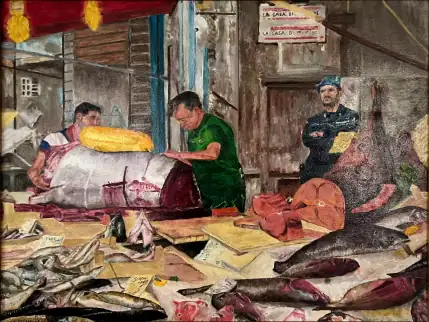
Threshing the Millet (Size: 30 x 40 inches) by Michael Doochin
In an age of acceleration, Michael Doochin paints slowly.
Not because he has to, but because it is how truth reveals itself.
Each of his works begins with presence. Before the composition, before the palette, there is the act of seeing. Truly seeing. The bend of light. The weight of a shadow. The subtle rhythm of a person walking through a field. “You can truly see as you pause in presence,” he says.
Doochin’s process is more than artistic. It is philosophical. To paint is to attend. And attention, in his hands, becomes a sacred practice.
Though he came to painting later in life, after decades of work in business, international travel, and authorship, his approach carries the quiet depth of someone who has lived many lives. His early career was shaped by precision and planning. His photography, which is part of the Smithsonian Institution’s permanent collection, honed his ability to notice the unrepeatable. And his spiritual training as a Healing Touch Practitioner and student of Kabbalah gives his work an unseen dimension, a quiet hum behind the form.
But it is his slowness that defines him.

Cutting the Tuna (Size: 20 x 24 inches) by Michael Doochin
In realist works such as Threshing the Millet or his celebrated fish market scene Cutting the Tuna, Doochin does not just recreate a moment. He reconstructs its emotional architecture. The figures move with rhythm. The light bends with purpose. Every object holds weight.
These effects are not accidental. They emerge over time, as he steps back and forth from the canvas, constantly testing how the viewer’s eye will receive what he is building. “A painting looks different from three feet away than it does up close,” he says. “So I paint for both distances. For both kinds of seeing.”
What he creates, then, is a layered experience. One that unfolds gradually, and rewards patience. The longer you stand before one of his works, the more it begins to speak.
His abstract paintings, which he calls “concretes,” are no different. They do not begin with form. They begin with energy. A color that calls to him. A movement that wants to happen. He starts, often in the center or slightly off to one side, and follows where the canvas leads.
“There is no map,” he says. “Only rhythm. Only trust.”
The result is work that feels alive. Not in the sense of motion, but in presence. His paintings hold space. They ask for time. And in that asking, they invite transformation.
This ethic of patience is not common in today’s visual culture. We are conditioned to scroll, to skim, to judge quickly. But Doochin’s work resists speed. It is not content for instant approval. It demands interaction.
Even in his most detailed realist scenes, there is a silence. A sense that the moment has been suspended just long enough for something deeper to emerge.
That emergence is not always logical. It is intuitive. Emotional. Philosophical. His use of color, especially, reflects this balance. Trained in the language of chakras and energetic resonance, he often selects tones that evoke specific inner states. Grounding reds. Soothing greens. Activating blues. But he is not formulaic. His intuition guides him, and he listens closely.
Painting, for Doochin, is not performance. It is alignment.
And alignment, he believes, is only possible through deep seeing.
That seeing often begins long before the canvas. During travel. In quiet moments of observation. Sometimes it begins in a photograph, an image taken during one of his journeys through more than sixty countries. These photographs are not references. They are memories. Reminders of feeling. Of energy.
“I look at them not to copy, but to remember what it felt like to be there,” he says. “To bring that feeling into the painting.”
His process is reflective. Meditative. A dialogue between the known and the unknown.
As he works, he makes decisions slowly. He changes direction if the energy calls for it. He allows doubt. He invites revision. “You do not need to finish something just to say it is done,” he says. “You need to stay with it until it says what it came here to say.”
This mindset is what makes his work philosophical. Not in its content, but in its method. Doochin paints the way a philosopher thinks, through questions, through presence, through continual refinement.
And like any good philosophy, his work does not offer answers. It opens space. A space where the viewer slows down. Begins to see. Begins to feel. Begins to ask.
In a culture that celebrates speed, Michael Doochin’s work is a quiet refusal. A reminder that meaning does not live on the surface, that truth is not rushed, and that to really see the world and ourselves, we must first learn to stop.
To stand still. To look again.
To paint, like a philosopher.
The acclaimed portrait artist Burton Silverman presents a striking depiction of Michael Doochin, conveying a sense of mutual admiration between creator and subject. Far beyond a simple representation, the portrait underscores Doochin’s growing influence in contemporary art and encapsulates the unique vision he brings to the modern artistic dialogue.
Michael Doochin’s body of work spans painting, writing, and photography. His online gallery presents a refined selection of his visual art, while his books, The Tzaddik and The Mystical Naturalist among them, offer a fusion of spiritual depth and lyrical prose. His striking photographic archive, chronicling cultural life across more than 70 countries, is also housed in the Smithsonian’s digital collection.